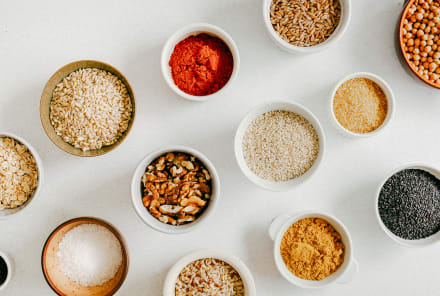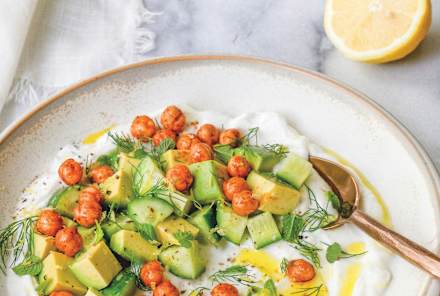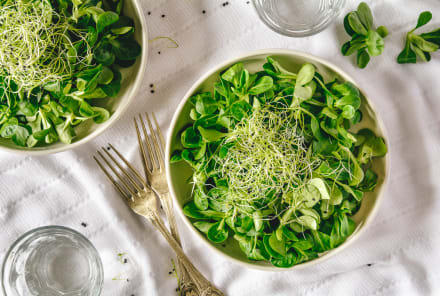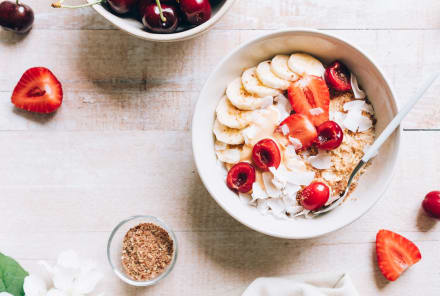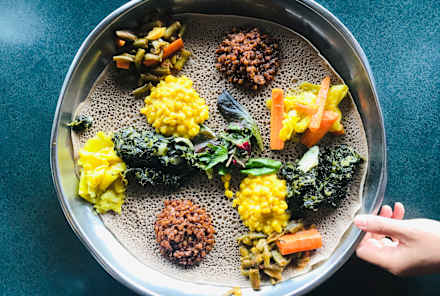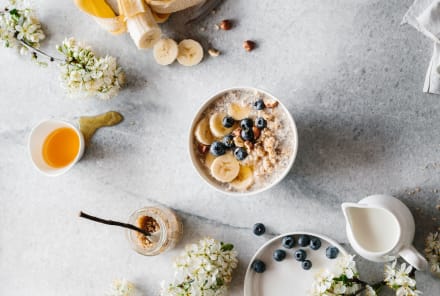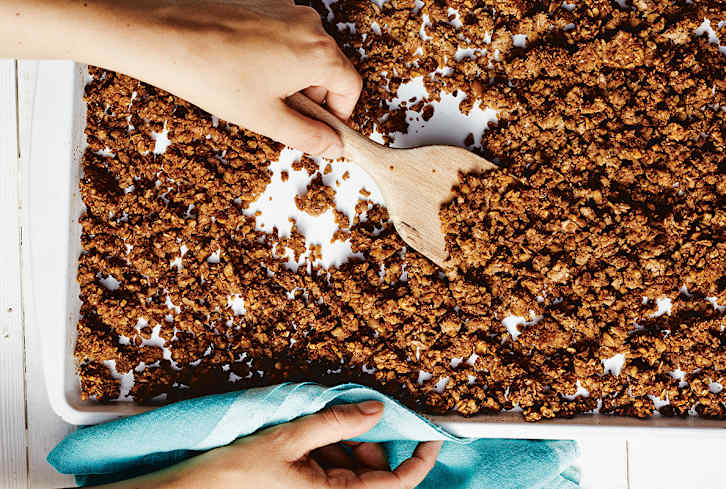Advertisement
The Gout Diet: Exactly What To Eat If You Have This Painful Form Of Arthritis


Once called "the disease of kings," gout has certainty spread beyond the castle walls. More than 8.3 million Americans1 suffer from this painful form of arthritis, and that number has been steadily growing. While gout is often associated with an overindulgent lifestyle, doctors now understand it can be caused by both genetic and lifestyle factors2. Luckily, there are many natural remedies and diet modifications you can make to reduce your risk or manage your symptoms. Here, we break down what's behind this debilitating disease and how to eat (and not eat) for relief.
The basics: gout symptoms, causes, and risk factors.
For starters, what exactly is gout? Gout is a common form of arthritis that causes pain and swelling in the joints, especially the toes and fingers. Symptoms flare up sporadically and typically clear up after about a week, according to the Arthritis Foundation. During this time, individuals may experience excruciating pain and trouble walking, and the affected joints can appear red and shiny. Individuals may go months or even years between gout attacks.
So, what causes these sudden painful symptoms? It turns out gout is the result of years of chronic hypouricemia3—excess uric acid in the blood. Uric acid is naturally produced by the body and is usually cleared by the kidneys and excreted. However, some people, due to genetics and lifestyle factors, produce too much uric acid or have trouble metabolizing it. The excess uric acid crystallizes creating needle-like urate crystals that accumulate in the joints. These crystals build up over decades and can go unnoticed in the joints for years. But anything from a stubbed toe to a night of drinking can cause the body to suddenly identify them as foreign and attack—causing the tell-tale inflammation and pain of gout. If left unmanaged, gout can lead to stone-like deposits, called tophi, and cause long-term joint damage.
There are a number of factors that can increase the risk of gout. First of all, it is important to be aware that gout primarily affects men4, striking 5.9 percent of men in the United States versus just 2.2 percent of women. However, ladies, that doesn't mean you're in the clear. Female hormones are protective against gout, so after menopause, women become more susceptible.
Another major risk factor: weight. In fact, one study found5 that gaining 30 pounds in early adulthood more than doubled the risk of developing gout later on. Interestingly, losing just 10 pounds reduced the risk of gout by 39 percent. This is because excess weight can burden the kidneys, making it harder to clear uric acid. Researchers also believe fat tissue may produce more uric acid6 than muscle tissue, further increasing uric acid levels.
Suffering from gout or worried you may be at risk? Not to worry, there are many things you can do to reduce uric acid levels in your body and ward off further attacks.
Limit purine-containing foods to manage gout.
Looking to lower your uric acid levels? You'll want to start by lowering your intake of purines. The breakdown of these natural compounds is what produces uric acid in the body7.
"Purine is naturally produced in the body and is also a compound in some foods. Most people can break down purines into uric acid just fine, but in some people it can form hard crystals in the joints that leads to pain and inflammation, which often results in gout attacks," says Frank Lipman, M.D., functional medicine physician and mbg Collective member.
"If you eat a lot of high-purine foods, you will likely have higher levels of uric acid stored in your body," he says. "The easiest way to keep your levels down is to limit or avoid high-purine foods such as fatty meats, oily fish, and most alcohol."
Medium-Purine foods
The following medium-purine foods should be limited to 4 to 6 ounces per day:
- crab
- lobster
- oysters
- shrimp
- beef
- chicken
- pork
- duck
- ham
High-purine foods
The following high-purine foods should be drastically reduced or avoided altogether:
- alcohol
- anchovies
- sardines
- herring
- cod
- trout
- haddock
- mussels
- scallops
- bacon
- turkey
- veal
- venison
- meat-based gravies and sauces
- liver and other organ meats
- yeast extract supplements
Completely eliminating purines may be too restrictive to maintain, but high-purine foods should be avoided to reduce the risk of repeated gout attacks. Work with your doctor to find the right balance of purines to manage your symptoms.
Interestingly, high purine vegetables have not been associated with increased risk of gout attacks. However, sugar-sweetened beverages8, although not high in purines themselves, have been shown to increase purine levels and risk of gout8. Researchers believe the high-fructose content of these drinks increases production of both uric acid and purines in the body. In fact, men who drank two or more servings of sugar-sweetened beverages per day had an 85 percent higher risk of gout than men who consumed them less often.
Another trigger to watch out for: niacin (aka vitamin B3). This B vitamin is present in many foods, and prescription niacin is often used to help control cholesterol. However, niacin has been shown to increase uric acid levels in the blood and therefore can exacerbate gout.
While avoiding purine-rich food and other triggers will help manage symptoms, medication may still be necessary to prevent the development of tophi and joint damage.
Scale back on most forms of alcohol.
Beyond food, you also need to watch what you drink when it comes to gout. Alcohol, especially beer9, has been shown to increase the risk of developing gout as well as trigger flare-ups. Drinking as little as two beers per day can more than double the risk of developing gout. In addition to being a rich source of purines, beer and other alcoholic beverages lead to decreased uric acid excretion, inducing hypouricemia. Some research, however, suggests that wine is generally less likely to cause gout flare-ups.
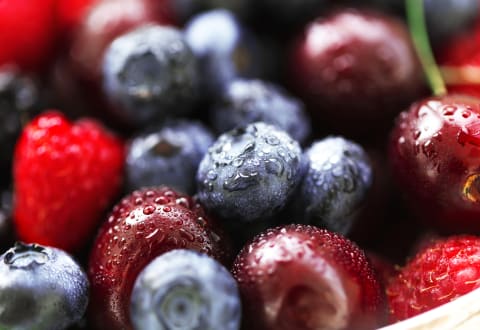
Eat these foods to reduce gout symptoms.
OK, now you know which foods not to eat, but what should you eat? It may seem limiting at first, but a low-purine diet can actually incorporate many of your favorite foods. You might also notice, a gout-friendly diet is also a heart-healthy diet. Gout has been linked to10 hypertension and cardiovascular disease.
One of the major risk factors for gout, in addition to cardiovascular disease, is being overweight or obese. Following a gout-friendly diet can help you manage gout symptoms and manage your weight, reducing risk for other chronic diseases. Here's what to include in a heart-healthy and gout-friendly diet.
- Whole grains
- Vegetables
- Fruits (but not fruit juice)
- Low-fat dairy products
- Lean meats
- Plant-based proteins such as lentils and beans
Try these other natural remedies for gout.
In addition to healthy lifestyle changes, there are some specific foods and natural remedies that can help reduce inflammation and tame gout symptoms. With supplements, always be sure to check with your doctor first to make sure they won't interact with your current medications.
Stinging nettle
This herb is known to be a natural remedy for all types of arthritis, including gout. This may be due to stinging nettle's strong anti-inflammatory properties, which can help ease the swelling and pain associated with a gout attack. Studies have shown that stinging nettle suppresses joint inflammation in those suffering from arthritic diseases. Try stinging nettle tea to calm inflammation.
Tart cherries
Tart cherries may just be one of the healthiest fruits out there. This delicious, vibrant fruit is chock-full of anthocyanins, a strong anti-inflammatory phytochemical that can help with joint pain and gout. They may even be as effective as NSAIDs 11at providing relief from inflammation. Along with being anti-inflammatory, tart cherries have been shown to reduce uric acid in the body. In one study, eating just 10 cherries a day12 helped prevent recurrent gout symptoms by 50 percent. Tart cherry juice is likely just as effective.
Vitamin C
Typically known for its immune-boosting properties, vitamin C may also help with gout. This is due to the vitamin's uricosuric effects, meaning it lowers uric acid levels in the body. In one study, high vitamin C intake was associated with a 45 percent lower risk of gout13. But positive results were seen with supplementation as low as 500 mg per day. So, try adding a vitamin C supplement to your routine or upping your intake with one of these seven delicious vitamin C-rich foods.
Coffee
If you like to start your day with a cup of joe, you're in luck. Studies have found that coffee consumption can increase uric acid excretion2. Study participants who drank 4 to 5 cups per day had a 40 percent lower risk of developing gout, and those who drank more than 6 cups per day had a whopping 60 percent lower risk. Can't take all that caffeine? Interestingly, decaffeinated coffee had a similar effect. Researchers believe this is due to the strong antioxidant properties of coffee. So, no matter which way you take your coffee, you can reap the benefits.
Water
Yup, good old H2O. Staying hydrated is always a good idea, but for gout sufferers in particular, increased water consumption can help stave off attacks. Boosting water intake has been shown to help the body flush out uric acid, lowering the risk for gout attacks. In fact, increased water consumption can cut the risk of hyperuricemia by up to 58 percent. A good rule of thumb is to aim for eight 8-ounce glasses per day, but hydration needs may vary based on physical activity, weather, and overall health.
Although gout is no longer thought of as a "disease of kings," it is true that overindulgence, especially in red meat and alcohol can increase risk and exacerbate symptoms. Whether you are looking to reduce your risk of developing gout or stave off future attacks, simple lifestyle modifications can make a big difference.
13 Sources
- https://www.ncbi.nlm.nih.gov/pubmed/21800283
- https://www.ncbi.nlm.nih.gov/pmc/articles/PMC4251556/
- https://www.thelancet.com/journals/lancet/article/PIIS0140-6736(09)60883-7/fulltext
- https://www.ncbi.nlm.nih.gov/pmc/articles/PMC3545402/
- https://jamanetwork.com/journals/jamainternalmedicine/fullarticle/486491
- https://www.ncbi.nlm.nih.gov/pmc/articles/PMC3779712/
- https://www.ncbi.nlm.nih.gov/pmc/articles/PMC3889483/
- https://www.bmj.com/content/336/7639/309
- https://www.ncbi.nlm.nih.gov/pubmed/15094272/
- https://www.ncbi.nlm.nih.gov/pmc/articles/PMC2684330/
- https://www.ncbi.nlm.nih.gov/pubmed/10075763
- https://www.ncbi.nlm.nih.gov/pmc/articles/PMC3510330/
- https://www.ncbi.nlm.nih.gov/pmc/articles/PMC2767211/

Why Nutrition Is Key To Changing Your Relationship With Alcohol
Brooke Scheller, DCN, CNS

Why Alcohol Sabotages Your Gut Health & How To Get Back On Track
Brooke Scheller, DCN, CNS

Why Nutrition Is Key To Changing Your Relationship With Alcohol
Brooke Scheller, DCN, CNS

Why Alcohol Sabotages Your Gut Health & How To Get Back On Track
Brooke Scheller, DCN, CNS

Why Nutrition Is Key To Changing Your Relationship With Alcohol
Brooke Scheller, DCN, CNS

Why Alcohol Sabotages Your Gut Health & How To Get Back On Track
Brooke Scheller, DCN, CNS

Why Nutrition Is Key To Changing Your Relationship With Alcohol
Brooke Scheller, DCN, CNS

Why Alcohol Sabotages Your Gut Health & How To Get Back On Track
Brooke Scheller, DCN, CNS
